Click on images to enlarge
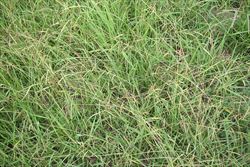
dense infestation (Photo: Sheldon Navie)
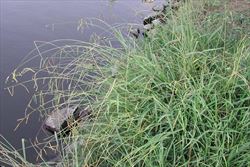
habit (Photo: Sheldon Navie)
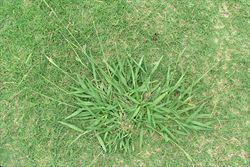
habit growing in a lawn (Photo: Sheldon Navie)

leaves and exposed old rhizomes (Photo: Sheldon Navie)
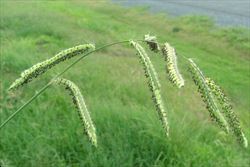
seed-head with several branches (Photo: Sheldon Navie)

close-up of flower spikelets (Photo: Sheldon Navie)
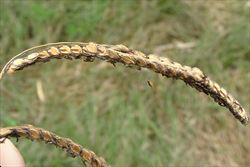
mature seed-head (Photo: Sheldon Navie)
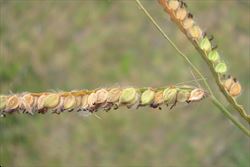
close-up of mature flower spikelets (Photo: Sheldon Navie)
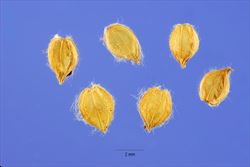
close-up of seeds (Photo: Steve Hurst at USDA PLANTS Database)

a fungus known as "ergot" often infests the seed-heads of this species (Photo: Sheldon Navie)
Scientific Name
Paspalum dilatatum Poir.
Family
Gramineae (South Australia)Poaceae (Queensland, New South Wales, the ACT, Victoria, Tasmania, Western Australia and the Northern Territory)
Common Names
bastard millet grass, caterpillar grass, common paspalum, Dallis grass, Dallisgrass, golden crown grass, hairy flowered paspalum, large watergrass, large waterseed paspalum, Leichhardt grass, paspalum, paspalum grass, water grass, water paspalum, watergrass
Origin
Native to South America (i.e. Brazil, Bolivia, Argentina, Chile, Paraguay and Uruguay).
Cultivation
Occasionally cultivated as a pasture grass.
Naturalised Distribution
A very widespread introduced species that is mostly found in the southern and eastern parts of Australia. It is common in eastern Queensland, eastern New South Wales, the ACT, Victoria, Tasmania, south-eastern South Australia and south-western Western Australia. Less common or occasionally naturalised in the southern and north-western parts of the Northern Territory, and in the inland parts of Queensland, New South Wales and South Australia. Also naturalised on Lord Howe Island and Norfolk Island.
Widely naturalised in other parts of the world, including southern Europe, tropical and southern Africa, Asia, the Mascarenes (i.e. Mauritius, La Reunion and Rodrigues), New Zealand, the USA and many Pacific islands (i.e. Hawaii, American Samoa, Fiji, New Caledonia, Niue and the Solomon Islands).
Habitat
A very common weed of gardens, lawns, footpaths, parks, roadsides, disturbed sites, waste areas, closed forests, open woodlands, crops and pastures in tropical, sub-tropical and temperate regions.
Habit
A long-lived (i.e. perennial) grass usually growing up to 1 m tall, but occasionally reaching up to 1.5 m in height. It forms large clumps via short creeping underground stems (i.e. rhizomes).
Distinguishing Features
-
a long-lived tufted grass growing up to 1.5 m tall.
-
its leaf blades are slightly folded at the base and are usually hairless.
-
its seed-heads are borne at the tips of the upright flowering stems.
-
these seed-heads have 2-11 branches (2.5-11 cm long) that are alternatively arranged along a main stalk.
-
each seed-head branch bears numerous small flower spikelets tha are covered with hairs.
Stems and Leaves
The flowering stems (i.e. culms) are sometimes branched near the base and their joints (i.e. nodes) are usually hairless (i.e. glabrous).
The leaves consist of a leaf sheath, which partially encloses the stem, and a spreading leaf blade. The leaf sheaths are hairless (i.e. glabrous), although sometimes the sheaths of lower leaves have a few long hairs (i.e. they are sparsely pilose). The leaf blades (6-45 cm long and 3-12 mm wide) are slightly folded at the base and are usually hairless (i.e. glabrous) with rough (i.e. scabrous) margins.
Flowers and Fruit
The seed-heads are up to 25 cm long and have 2-11 branches (i.e. racemes) that are alternatively arranged along a main stalk. The branches (2.5-11 cm long) contain numerous flower spikelets that are borne in pairs, and appear to be arranged in four rows. These flower spikelets are covered with hairs and consist of a pair of bracts (i.e. glumes) and two tiny flowers (i.e. florets), only one of which produces a seed. Flowering occurs mainly during spring and summer.
The seeds (i.e. caryopses or grains) are oval (i.e. elliptic) in shape and 3-4 mm long. They are shed still contained within the remains of the flower spikelets.
Reproduction and Dispersal
This species reproduces mainly by seed, which are dispersed by wind, water, animals, vehicles, machinery, and in contaminated soil and agricultural produce.
Environmental Impact
Paspalum (Paspalum dilatatum) is regarded as an environmental weed in Queensland, New South Wales, Victoria, Western Australia and South Australia.
Legislation
Not declared or considered noxious by any state government authorities.
Management
For information on the management of this species see the following resources:
- the Paspalum page on the South Coast Weeds website at http://www.esc.nsw.gov.au/Weeds/index.asp.
Similar Species
Paspalum (Paspalum dilatatum) is similar to other closely-related grasses, including broad-leaved paspalum (Paspalum mandiocanum), Bahia grass (Paspalum notatum), Vasey grass (Paspalum urvillei), scrobic (Paspalum scrobiculatum) and tussock paspalum (Paspalum quadrifarium). These species can be distinguished by the following differences:
- paspalum (Paspalum dilatatum) is a moderately-sized grass (usually about 1 m tall) with relatively narrow leaves (up to 12 mm across). It has relatively large flower spikelets (3-4 mm long) with long silky hairs on their margins and its seed-heads usually only have 3-7 branches (i.e. racemes).
- broad-leaved paspalum (Paspalum mandiocanum) is a low-growing grass (less than 1 m tall) with relatively broad leaves (up to 20 mm across). Its relatively small flower spikelets (2-2.5 mm long) do not have long silky hairs on their margins and its seed-heads usually have only 3-10 branches (i.e. racemes).
- Bahia grass (Paspalum notatum) is a low-growing grass (usually less than 60 cm tall) with relatively narrow leaves (up to 10 mm across). Its relatively large flower spikelets (2.75-4 mm long) do not have long silky hairs on their margins and its seed-heads usually have only two branches (i.e. racemes).
- Vasey grass (Paspalum urvillei) is a tall grass (1-2.5 m tall) with relatively narrow leaves (4-9 mm across). It has relatively small flower spikelets (2-3 mm long) with long silky hairs on their margins and its seed-heads usually have 10-20 branches (i.e. racemes).
- scrobic (Paspalum scrobiculatum) is a moderate-sized grass (usually 0.5-1.5 m tall) with relatively narrow leaves (3-12 mm across). Its relatively small flower spikelets (2-2.5 mm long) do not have long silky hairs on their margins and its seed-heads usually have only 2-7 branches (i.e. racemes).
- tussock paspalum (Paspalum quadrifarium) is a tall grass (1-2 m tall) with relatively narrow leaves (4-9 mm across). Its relatively small flower spikelets (2-3 mm long) do not have long silky hairs on their margins and its seed-heads usually have 15-25 branches (i.e. racemes).
Notes

